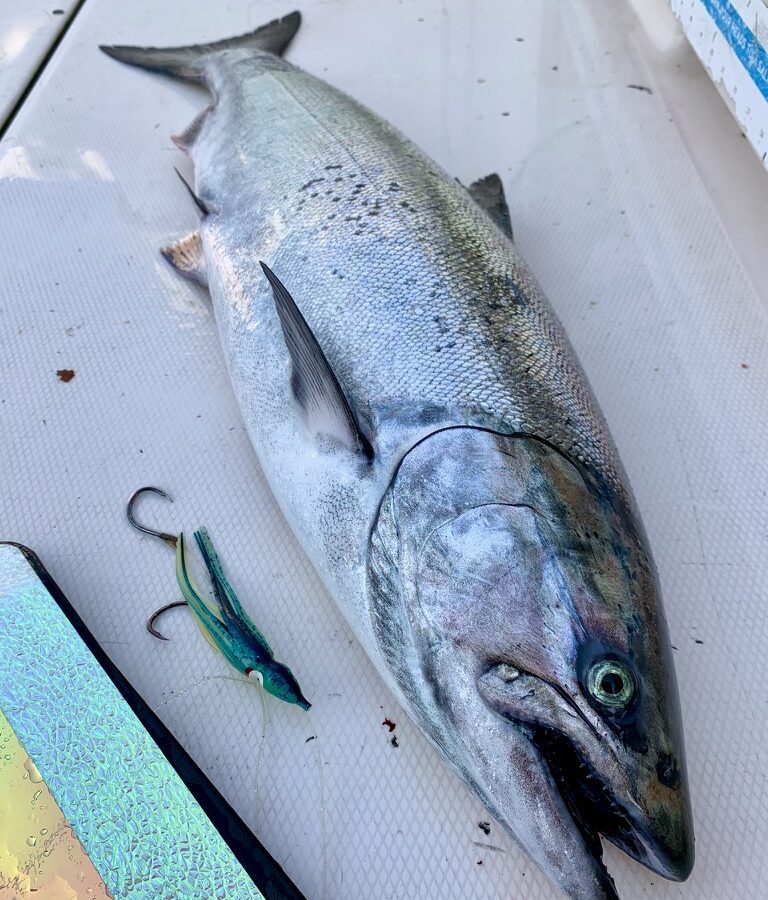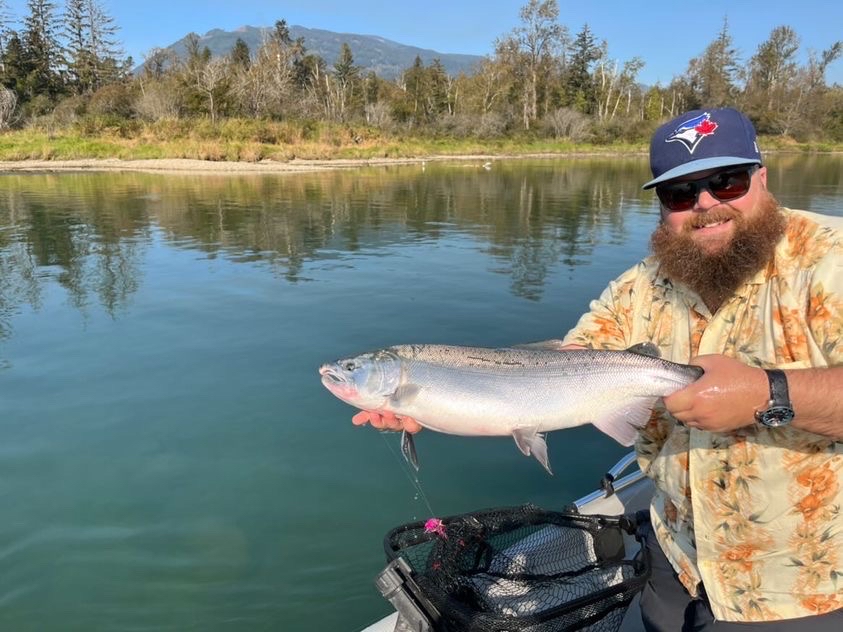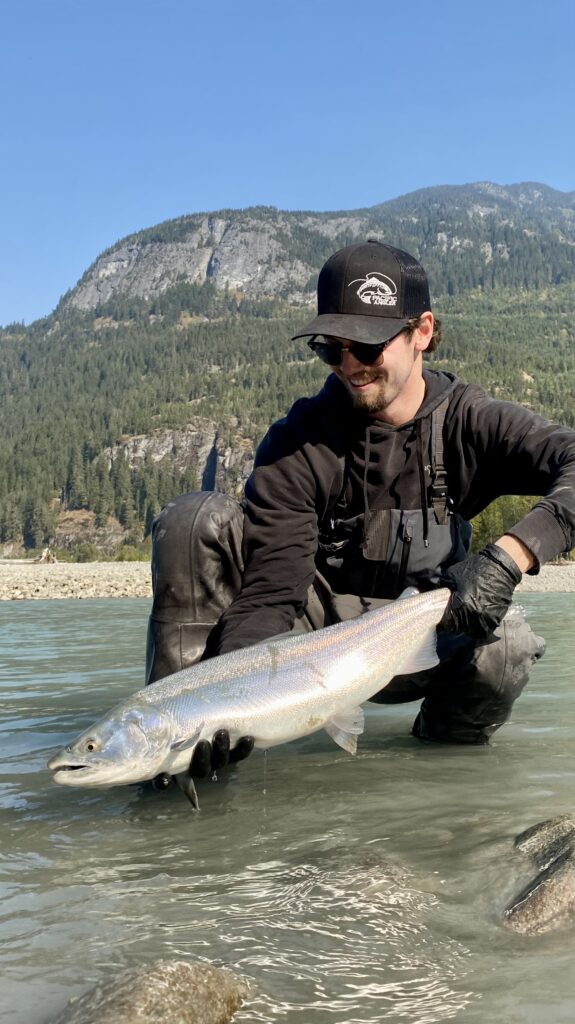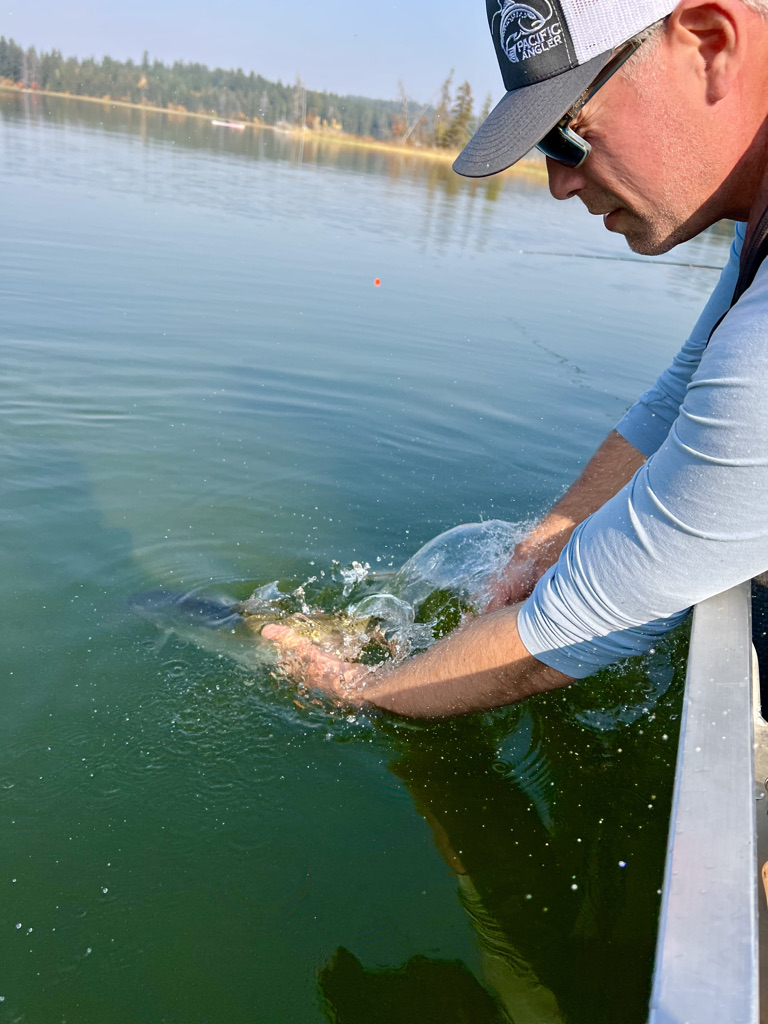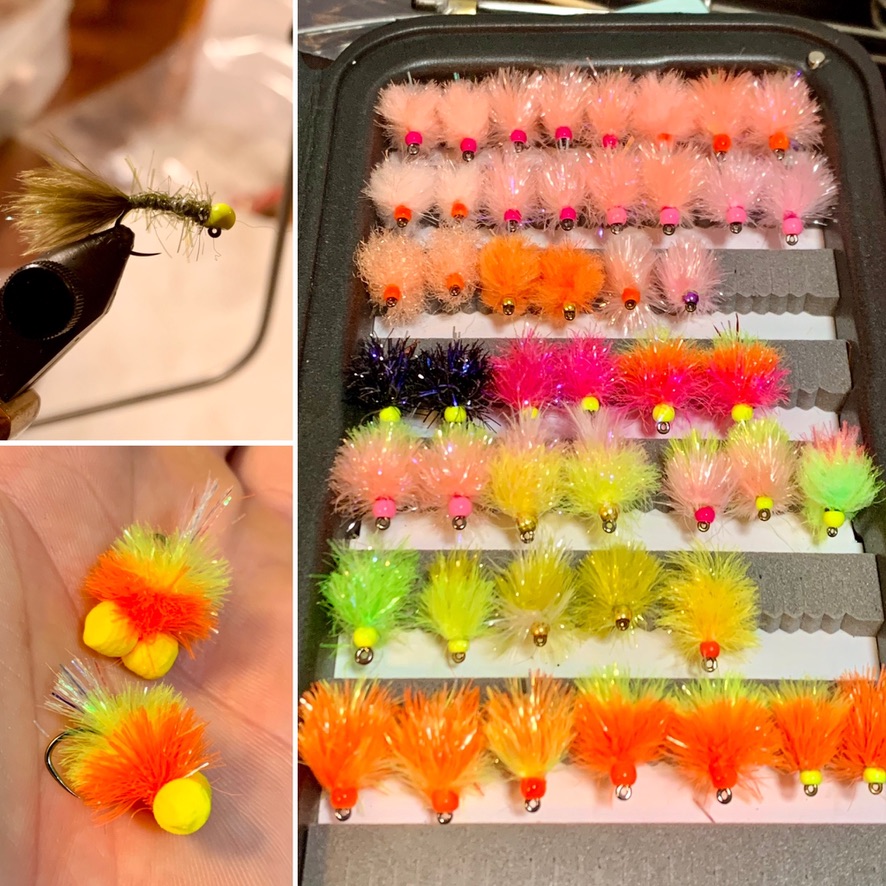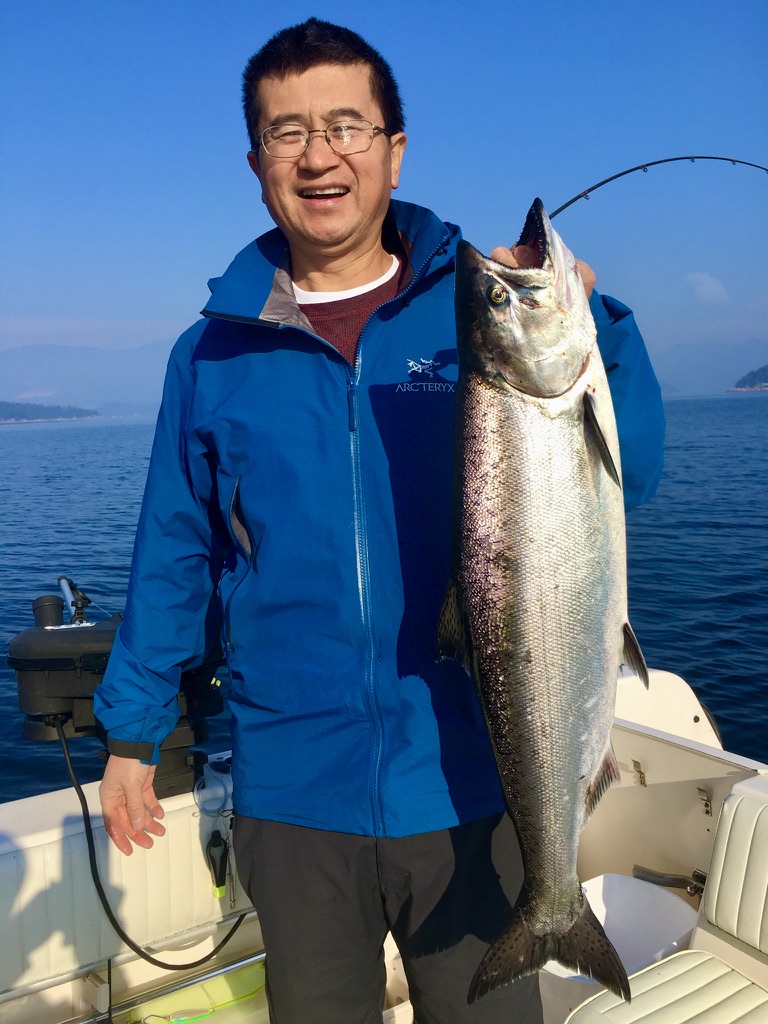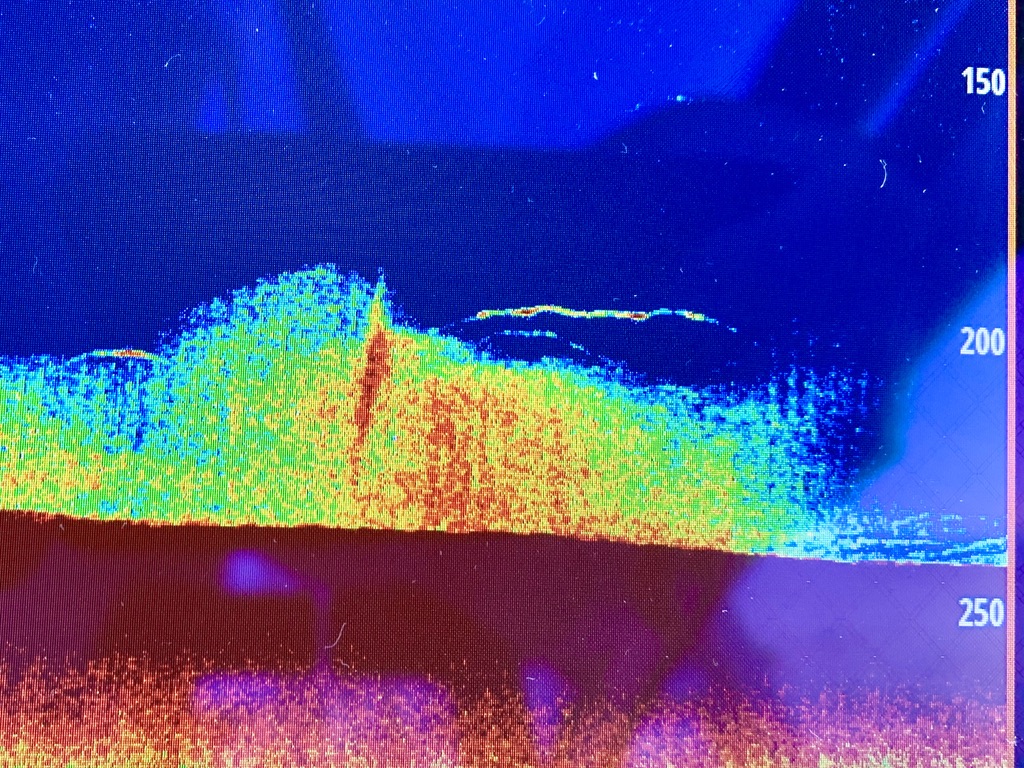OUTLOOK
We finally have some more typical Vancouver fall weather (aka rain) on the horizon and we can sure use the water. The question is how much water will actually come? Will it be enough to get river levels up? Will it be perfect and blow out the rivers but come into shape quickly? Or, will it be way too much water? The weather man has been all over the map when it comes to the amount of rain coming but it’s a pretty safe bet that rain is on the way.
In this week’s report, we look at what conceivably will happen to our major systems and how to be prepared. Jason also tunes in for another interior lake fishing report. He has been in the interior for the last 4 days. Water temperatures are still high for this time of year but more seasonal temperatures are coming and the fishing was good. Check out the freshwater and stillwater sections of the report below for all the details.
Matt also tunes in with the video report where he goes over the forecast, fish numbers as well as some salmon regulation clarifications that have been confusing a few anglers. Click below for the video version of the report.
On to the report
CLASSES AND COURSES
Fly Fishing Egg Patterns
This course is designed to teach you the secrets to one of the most productive presentations in the BC fly fishermen’s arsenal; nymphing egg patterns. This deadly method can be used for different species of trout, char, and salmon. During a 3 hour evening seminar we will teach you key concepts, strategies, and gear that will give you a well-rounded foundation during the seminar portion of the class. Then you will put those skills into practice during a fully guided day on the water.
In-Person Seminar : Nov 16, 2022 SOLD OUT – WAITLIST AVAILABLE
Seminar Only Cost: $50.00+GST
Seminar & Guided Walk ‘n Wade Cost: $275.00+GST per angler, minimum of 2 anglers per guided day on the water
Seminar Time: 6:30pm – 9:30pm
Guided Walk’n Wade: Full Day, Nov 19 or 20, 2022
FRESHWATER FISHING REPORTS
Chilliwack/Vedder River Fishing Report
Unless you’ve been living under a rock for the past week, you’re probably aware of the fact that there’s finally some rain in the forecast. This is a good thing, no doubt, but what does it mean for anglers? How will the rivers react to the first significant rainfall in over two months? Will the rivers be fishable for the weekend?
The real answer to all of the above questions is that I don’t know. What happens will depend entirely on how much rain actually falls, and how fast it falls. The ground is currently very hard and dry, so it won’t absorb much water- this means that most of the rain that does fall will run directly into storm sewers, ditches, creeks, and rivers instead of filtering slowly through the water table, which will likely result in rapid increases in water level and turbidity. This, of course, is known as a “blow out”, which is a dreaded term for most anglers. The fact that it hasn’t rained in months also means that there’s a lot of dust, dirt and other junk that has accumulated on the roads, river banks and everywhere else, which will be washed into the rivers and will also contribute to the increased turbidity.
Of course, the amount of rain that falls, and how quickly it falls will dictate if, or how much, the rivers blow out. A lot of rain over a short period of time- think 20-30mm in a day, is bad news for anglers, but 20-30mm over three days isn’t bad at all. The more time the rain has to be absorbed into the ground, the less likely we are to see a complete blow-out. While this is true for all systems, I’m going to use the Chilliwack/Vedder as my main example. The current forecast for Chilliwack is “periods of rain on Friday, chance of showers Saturday, sun and cloud Sunday, and rain/showers from Monday to Thursday”. If I had to make a prediction of what would happen, I’d guess that it’ll be fishable until late-Monday/mid Tuesday, depending on how hard it rains during those “periods of rain”. Now, I’m not a meteorologist nor a soothsayer, so this is an educated guess based on the forecast at this moment.
You can check river levels before you go here. A large, sharp spike on the water level graphs is something you don’t want to see. That means a lot of rain has fallen in a short period of time, and the river is likely blowing out. A more gradual increase is far more likely to be fishable, but there are exceptions. As a general rule, the first significant rainfall of the fall blows out the river, just because there’s so much loose dirt, dust, silt and junk that has accumulated over the summer that gets washed into the water by the rain.
The rain will be both a good and bad thing for the fish, as well. On one hand, they desperately need higher water levels to be able to move upriver effectively, but on the other hand, they could do without the wave of turbidity and water-borne junk that they’re inevitable going to encounter. There are a ton of fish holding up in the lower reaches of all of the major salmon-bearing streams right now, and It’s pretty much guaranteed that all of those fish will move when the water level starts to rise. This may or may not result in good fishing, depending on how quickly the water gets dirty. There could be five hundred fish in the pool in front of you, but you’re not going to get many bites if they can’t even see your gear.
The long story short here is that there’s a lot of uncertainty in how things will go during this rainfall. A blowout is likely, but it’s hard to say when, and fishing may or may not be good leading up to the blowout depending on turbidity and how fast water levels rise. The only real way of knowing for sure is to get out there, fish, and find out. As long as you’ve got 1 foot of visibility to work with, you’re not wasting your time. The fish have to move, and they’re going to move as soon as they start to smell the rain and feel the flow increase. There’s a potential for some epic fishing in the days ahead… but also a potential for a season-ending blowout… and flooding.
Taylor Nakatani
Harrison River Fishing Report
The Harrison continues to produce good fishing this week and will probably for a while. Good numbers of coho as well as chum are in the system and only more are to come. The water has been clear and the fish have proved to be spooky but the rain coming this week shall change things.
Twitching jigs, spinners and spoons have all been highly effective on fish that have not been bothered yet.
A lot of coho have been found tucked in log jams, which is where the art of twitching
can reign supreme. Flipping log jams for coho is a very effective way to get in front of tricky fish; the key is to know when to twitch and when to drop. Inevitably, you will lose a few jigs figuring it out. I prefer to cast slightly outside of the log jam and let it sink until you feel the bottom and commence your light twitches. If your twitch is too excessive, you are bound to snag the logs, having braided lines is key; often times you will feel the line on a branch and you are able to suspend your jig on top of fish. More often than not, coho will actually swim away from the log jam once hooked, consequently freeing you from the branch.
Please keep in mind that there are a lot of sockeye and chinook in the system as well; they are not to be targeted as there are no legal opportunities to fish for them on the Harrison. Inevitably, they are going to be a bycatch; especially sockeye which cannot resist a properly twitched jig, so be sure to handle all fish with care.
Fly anglers have been having success with smaller patterns such as Cali Neils, Arrowheads, Muddlers in sizes 6,8,10. Clear intermediate lines with 6-12ft leaders has been essential to not spooking coho in our current conditions. Look for jumping fish in stagnant frog water, the rain we are anticipating this week will only help with the coho getting more comfortable, colder water temperatures are vital to getting coho on the fly.
See you in the shop or on the water,
Gavin Lau
Squamish River Fishing Report
I was up scouting last week on the Squamish and want to start off this report by giving a warning about rafting. Some areas are clear but there are some sections of the river that have some concerning log jams. We recommend anyone rafting use caution and in our opinion it’s not the time to be learning how to raft on the Squamish.
On the fishing side of things, the main river is still very coloured and with less than 4 inches of visibility it’s a challenge to get fish to see your presentation. That said, there are fish in the system. We used some massive flies and spoons that have been in my box for years because they were “too big”. These spoons were debatably too small for the conditions but we managed to hook a few coho.
There are also chum in the system but you are not allowed to target them right now. There has been some confusion on the salmon regs in region 2 when it comes to species not listed on the region 2 salmon regulations page. We go over it in detail in the video version of the report this week so check that out if you are scratching your head and check out this link if you are having trouble finding the regulations. Here is the link.
For things to change we really need to see cold nights and some precipitation. We have a fair chunk of rain in the forecast and when the storm passes, we will start to see more seasonally cold weather. With any luck, after the storm, we will see clearer water conditions.
If you are heading out make sure to watch the river levels website to make sure things are safe!
Matt Sharp
STILLWATER FISHING REPORTS
Interior Lake Fishing Report
I had the good fortune of being asked to fish with Brian Chan this week, to film a Fish BC fall lake fishing feature. I fished 3 lakes in the Kamloops region and had a great time; let me tell you about it.
First off, it was hot. Each afternoon I was down to a t-shirt after being bundled up in the morning because it was -2C and frost on the windshields. In the afternoon it was as hot as 22C. These hot days are keeping water temps unseasonably warm. On the lakes we fished the water was 52 to 55 on two of them and on one of them it was 59! Usually, the temps would be in the mid to low 40’s and the fall season would be well on its way. This year it is practically just getting going and the fish were as deep as 15 feet in some cases. Luckily, we did find some fish where we hoped to find them, in that 5-10 foot zone and we could throw some fall tactics at them.
We did well with straggle string leeches tied with head turner beads in green shades (olive and lichen) with a chartreuse bead and of course the vampire colour pattern which is black/purple with a chartreuse bead. We fished these flies under an indicator about a foot off the bottom anywhere form 4 feet of water out to about 12 feet. When that wasn’t working, we also caught fish on blobs. Biscuit and prawn seemed to be the two most productive shades with a pink or orange bead. When the bobbers weren’t going down but fish were showing, out came the Tequila Booby. This proved effective overall and saved the day on the last lake we fished. At the end of 3 days, despite the warmer than usual temps, we had some good “classic” fall fishing with leeches and blobs in the shallows and stripping booby flies when that wasn’t working.
Looking at the 7 to 14 day forecast it looks like fall is coming in hard, with some cool temps and snow in the forecast for the interior. I guess the sun and heat is finally coming to an end. Time to start watching the weather and seeing what days you can actually make it back to the interior lakes as there will be some snowstorms on the Coquihalla Highway. When we can get back, I suspect lake temps will finally be into the 40’s and even more fish will be up in the shallows looking for some food before the ice up starts. I hope to get up there again to experience that.
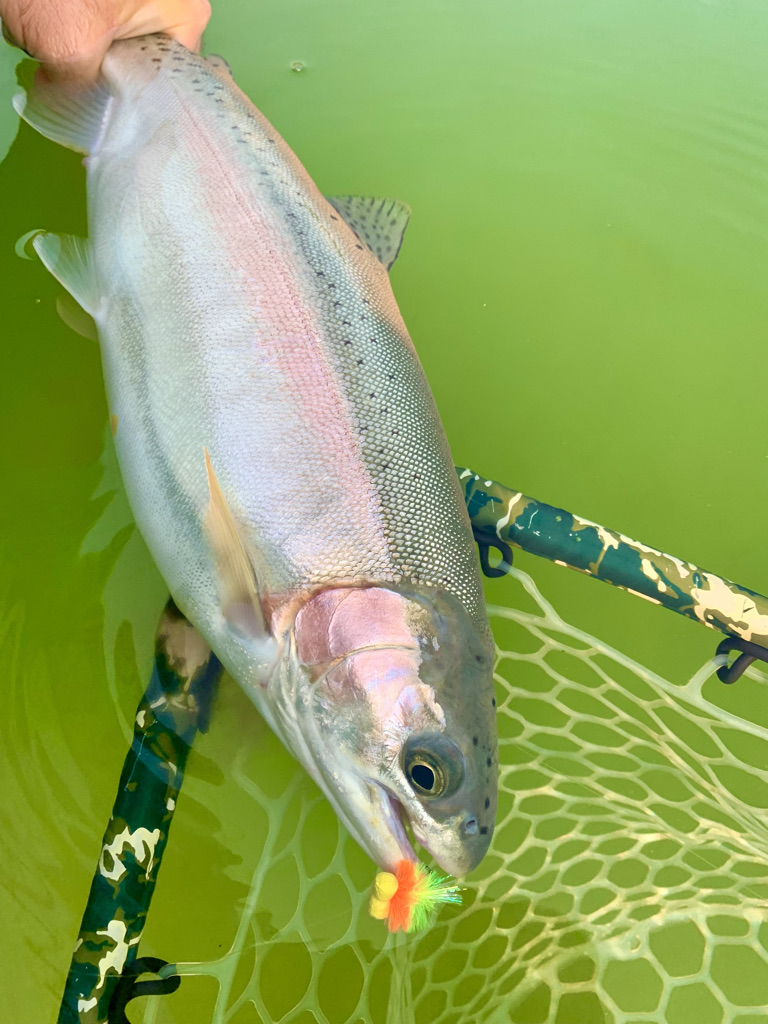
If you are heading up, make sure you have a variety of flies ready to strip, like boobies, leeches, and scuds. You will also want some flies to hang under the bobber like leeches and blobs. Being ready to do both with floating lines rigged and different sinking lines, combined with moving around a lot to find willing fish, is key to success in the fall.
See you in the shop or on the water,
Jason Tonelli
SALTWATER FISHING REPORTS
Vancouver Saltwater Salmon Fishing Report
It’s late October and the vast majority of migratory chinook and coho are heading up the rivers. Any late comers will certainly be triggered to move into the Fraser with this low-pressure system and the rains. We still need quite a bit of rain to raise the local and VI rivers, so I hope we get it, as the fish desperately need it.
Local ocean effort has switched over to “winter chinook” aka “feeder chinook.” These are fish that are going to spawn next year and are aggressively feeding in local waters. Size will range from undersize (min size limit is 62 cm) to fish as big as 15 pounds or the high teens. The vast majority tend to be in the 8-12 pound range. Different waves of these fish will show up throughout the winter into the spring months. Some of the general areas we fish are Vancouver Harbour, Howe Sound, and the Gulf Islands.
These fish are usually caught very close to bottom because that is where the bait is. In the winter the water is clear and the bait, usually 3 to 5 inch herring, likes to keep close to bottom during the day to hide from predators like birds, seals, and of course chinook. So, in the winter, expect to keep your gear within 10% of the bottom for consistent success. This means keeping a keen eye on your chart plotter and sonar and working those riggers up and down to stay in the zone. This is not a “set it and forget it” fishery, you need to be very active in your boat control and downrigger control and that is best done with 2 anglers. One angler is steering and managing location and speed and one is watching the rods and raising or lowering the riggers as needed.
In the winter the adage “find the bait and find the fish” is very true. These feeders are cruising around looking for bait and if there isn’t any there, they are going to keep moving. I like to spend about an hour in a spot and if I haven’t marked bait and fish I am going to move as well. Good electronics really pay dividends in the winter fishing. When we are having good action, we are always marking good bait balls and literally seeing the chinook on the bottom feeding on the bait. You have probably seen my pictures in past winters of this and expect some more this year. I love the sonar shots of bait and chinook!
When it comes to gear, glow flashers and glow spoons are usually the way to go. Some of my favorites are a black flasher like the PA Custom 50/50 in black made for us by Oki Tackle and the Gibbs CB55. That paired with a 3.0 or 3.5 Herring Aid spoon in Kingfisher, G-Force, Skinny G or Koho Killer style and you are going to catch some fish. Other days the fish prefer brighter gear and a chartreuse glow flasher such as the Salty Dawg or Lemon Lime with an Irish Cream spoon in the same sizes and models listed above will work well. If you like hootchies, those will work too, so you can use a glow blue splatter hootchy with the black flasher and a glow chartreuse splatter hootchy with the chartreuse flasher.
I usually start with the black gear on one side, the chartreuse gear on the other, drop both to just off bottom and let the fish decide what they want. Usually on the sunnier days the darker gear works better and on the overcast and grey days the chartreuse gear works better.
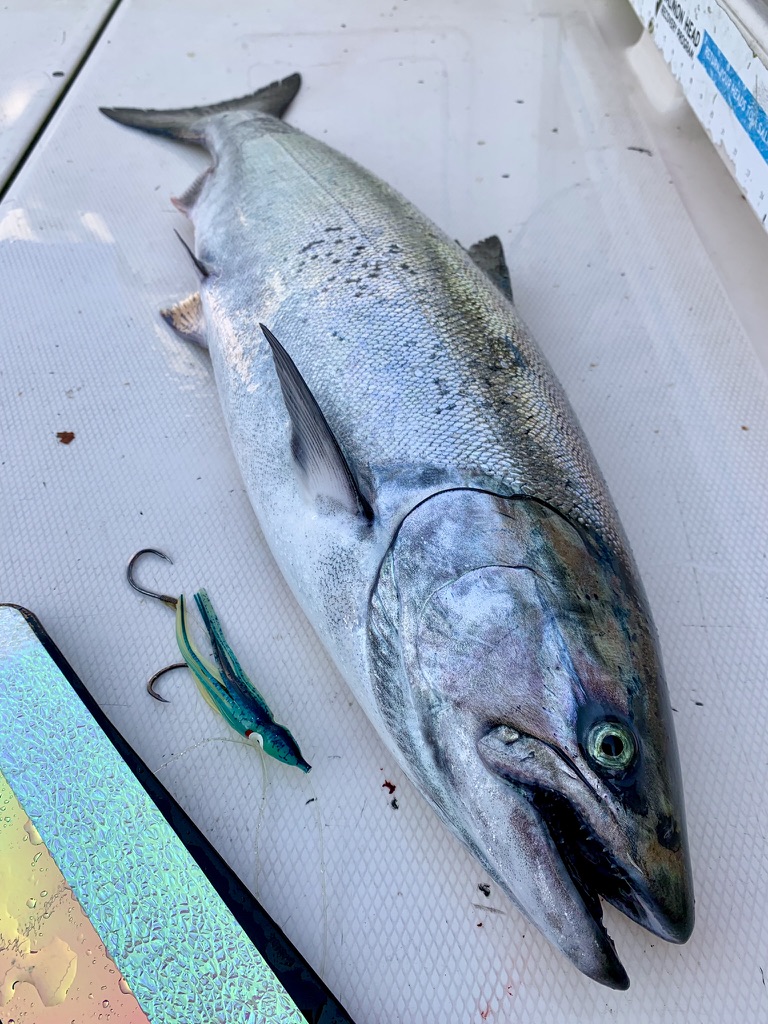
Fishing has been decent already and it seems the “winter season” starts earlier an earlier each year as our summer chinook opportunity has been reduced by DFO. So, I guess I will see some of you out there this winter. Happy hunting!
See you in the shop or on the water,
Jason Tonelli


